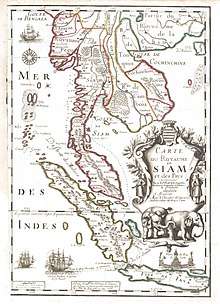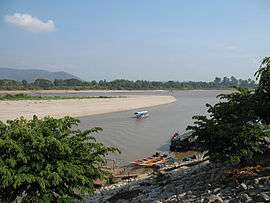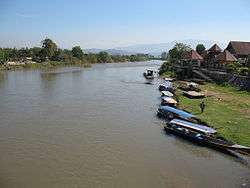Singhanavati
The Singhanavati (Thai: สิงหนวัติ; RTGS: Singhanawat) Kingdom was based along the Kok River, in the Chiang Rai Basin in northern Thailand. The ancient Lanna society of northern Thailand is considered more progressive than many other societies in other regions of the same period because the Lanna people recorded their history and social development. Records concerning cities in the Chiang Mai and Chiang Rai basins have proved well-grounded. Many stone tools have been excavated in this area. Settlements in this region are supported by Thai north chronicle and the record of Yonok-nagabundhu, which is about people migrating to settle in this region.
Part of a series on the |
|---|
| History of Thailand |
 |
|
Legendary Suvarnabhumi Central Thailand Dvaravati Lavo Supannabhum Northern Thailand Singhanavati Ngoenyang Hariphunchai Lanna Southern Thailand Pan Pan Raktamaritika Langkasuka Srivijaya Tambralinga Nakhon Si Thammarat Sultanate of Pattani Kedah Sultanate Malacca Sultanate Satun Reman |
| History |
|
Regional history |
|
Related topics
|
|
|
Location of Sinhanavati Kingdom
Sinhanavati Kingdom was on the Kok River, which descends from the mountain in Fang District (Chiang Mai Province), and runs into the Kong River east of Chiang Saen District (Chiang Rai Province), from which the city itself was at a distance of about 3 kilometres (1.9 mi). The city was submerged below Chiang Saen Lake due to an earthquake.
Kururath-Indrapath Kingdom

Due to a disaster, Samantaraja of Pataliputra obliged all his people to follow him to the region of Bodhisaanluang. He built the city of Indrapath which he surrounded with a stone wall. His daughter married Kuruvamsa, the grandson of Samantaraja's minister, who built the nearby city of Kururath.
When the king of Bodhisaanluang learned of the new settlements in his territory, he declared war against them, but eventually he was defeated.
Kuruvamsa reigned and promoted both cities, Kururath–Indrapath as the capital of the new kingdom. Three other kings succeeded him: Sirivamsa, Indravamsa, and Indrapathom.[1]

Umongasela city
The royal counselor of King Indrapathom, Aya-Uparaja, who was also the king's uncle and father-in-law, had resigned from his position. King Indrapathom assigned Bahira-Brahmin to be his new royal counselor.
Bahira-Brahmin was dishonest, and was banished from the capital. He then went to ask for help from Suvarnamugadavaan of Suvarnagomgum City, who let him come to build the new city at the source of the Kok River, named the city of Umongasela (present-day Fang). [1]
Suvarnagomgum city
Aya-Uparaja resigned and came to the new city which Bahira-Brahmin had built. This city was a three-month journey along the Mekong River from Bodhisaanluang City. The next ruler, Suvarnamugadavaan, the seventh grandson of Ayauparaja, was assigned by King Indrapathom to rule this city. Later he renamed the city Suvarnagomgum.[1]
Later still this city was ruled by Kom-dum, the Khmer ruler who was corrupt, and therefore resisted by the local populace. Due to a flood, Suvarnagomgum was inundated by the Kok River, where now it is known as Wieng-Prueksha. The survivors evacuated to Umongasela City and this district has been abandoned since then.[2]
Singhanavati kingdom
Around 757 CE, Khun Saiphong, one of the sons of Khun Borom of Tai-desa, obliged his people to follow him from northern Myanmar across the Salween to this region. The title Khun before his name marks his status as a ruler of a fortified town and its surrounding villages, together called a mueang.[3] After his period of rule ended, there was no successor. Therefore, his uncle, Sinhanavati came in 773 CE and built the city named Nagabundhu-Singhanavatinagorn, due to the support given him by the Naga. The new city was located near to the submerged Suvarnagomgum City, and forty-five other kings succeeded him.
Singhanavati Kingdom subjugated Umongasela City, which was then ruled by the Khmer, and other nearby states to extend its territory. Sometimes it was defeated, for example in the reign of Pra-ong Pung the royal seat was removed to the nearby city of Paan-gum, a city on the Sai River (Chiang Rai's northernmost district), but it eventually restored its independence.
The last king of Singhanavati Kingdom was named Phramahajaijana. In his reign, Singhanavatinagorn was submerged in Chiang Saen Lake due to an earthquake.[4]
The survivors went east to inhabit Wieng–Prueksha, led by Khun Lung. For 93 years, they selected their ruler from among the leaders of their 14 villages to rule the region. After this period, the record mentions the development of high land communities, led by Lavachakaraj,[5] which later were the beginning of the Lanna Kingdom and continued through the founding of Chiang Mai City at the end of the 13th century.[6]
La Loubere's record

Simon de la Loubère's record refers to the first king, named Pathomsuriyadhep (Singhanavati). The chief place where he kept his court was called Jayaprakaan Mahanagorn (Nagabundhu-Singhanavatinagorn, Chiang Rai Province), and he began to reign in 1300. Ten other kings succeeded him, the last of whom, named Dipayasoondorndhep, removed his royal seat to the city of Dhatu Nagornluang (Nan) which he had built, the location of which is also uncertain. The 22nd king after him, whose name was Boromjayasiri, obliged all his people in 1188 to follow him to Nakhon Thai (Pitshanulok). But this prince did not always reside at Nakhon Thai, for he came, built, and inhabited the city of Pipeli (Petchaburi). Four other kings succeeded him; of which Ramadhiboti, the last of the four, began to build the city of Thailand (Ayudhya) in 1351, and there established his court.[7]
References
- The north chronicle.
- Thai chronicle, chapter 72, The legend of Suvarnagomgum.
- Terwiel, Barend Jan (1983). "Ahom and the Study of Early Thai Society" (PDF). Journal of the Siam Society. Siamese Heritage Trust. JSS Vol. 71.0: image 4. Retrieved 7 March 2013.
- The chronicle of Yonok-nagabundhu
- The chronicle of Hiranyanagorn-ngernyang
- The chronicle of Chiang Mai
- M. de la Loubere, "A New Historical Relation of the Kingdom of Siam London", Chapter 3-Concerning the History and Origin of the Siamese, p.8.